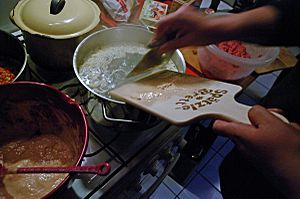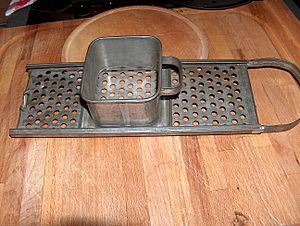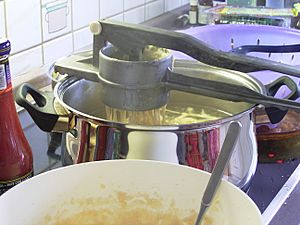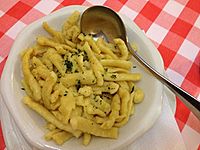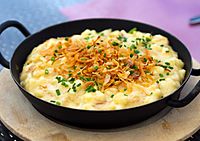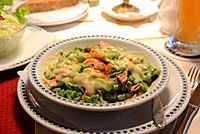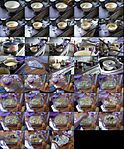Spätzle facts for kids
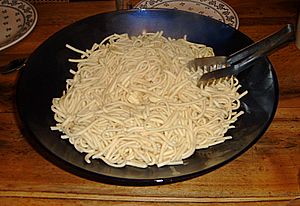
Commercial thin spätzle, served with butter
|
|
| Place of origin | Germany, Central Europe |
|---|---|
| Main ingredients | Egg noodles (flour, eggs, salt, water) |
Spätzle (say it: shpetz-luh) is a special type of pasta or dumpling. It's made with eggs and is often served as a side dish with meat and gravy. You'll find Spätzle most often in the Swabia region of Germany. It's also popular in other parts of southern Germany, Austria, Switzerland, Hungary, Slovenia, Alsace, Moselle, and South Tyrol.
Contents
What Does Spätzle Mean?
The name Spätzle comes from the Swabian word Spatz. This word means "little sparrow". So, Spätzle literally means "little sparrows"!
People also call them Knöpfle, which means "small buttons". In Switzerland, they might be called Spätzli or Chnöpfli. In Hungary, you might hear them called Nokedli, Csipetke, or Galuska.
Before machines were used, people shaped the pasta by hand or with a spoon. The little pieces looked like tiny sparrows. This is how they got their name! Knöpfle describes the small, round shape of the pasta. Both names, Spätzle and Knöpfle, are used for the same food.
A Quick Look at Spätzle History
No one knows exactly where Spätzle first came from. Many different regions say they invented it!
The tradition of making Spätzle goes back a long time. People have been making it since at least the 1700s. Some old pictures from the Middle Ages even show pasta that looks like Spätzle.
Long ago, a grain called Spelt was very common in the Swabian area. Spelt grows well even in poor soil. It was popular because it has a lot of protein. This meant people could make dough without needing eggs, which was helpful when times were tough.
Over time, as people became more prosperous, Spätzle changed. It went from being an everyday food to a special dish. It was often eaten on holidays and at celebrations.
Today, Spätzle is a famous food from Swabia. It's especially linked to the German state of Baden-Württemberg. In France, it's connected to Alsace and Moselle. Every year, about 40,000 tons of Spätzle are made in Germany! You can also find pre-made Spätzle in stores around the world.
Special Protection for Swabian Spätzle
Since 2012, Swabian Spätzle and Swabian Knöpfle have a special label from the European Union. This label is called "Protected Geographical Indication (PGI)".
This means that to be called "Swabian Spätzle," the food must be made in a certain way. Also, at least one part of its creation must happen in the defined region of Swabia. It's like a special stamp of approval for regional foods!
How Spätzle is Made
Spätzle dough usually has just a few ingredients. These are mostly eggs, flour, and salt. A common rule in Swabia is to use one more egg than the number of people eating. Sometimes, a little water is added to make the dough thinner.
The flour used for Spätzle is usually bread wheat. It's a bit coarser than regular baking flour. This gives Spätzle a nice, chewy texture.
Traditionally, people make Spätzle by scraping thin strips of dough. They use a wooden board (called a spätzlebrett) and scrape the dough into boiling salted water. The Spätzle cooks until it floats to the top. Then, it's scooped out and set aside.
Making Spätzle by hand can be tricky. So, people invented different tools to help! These tools look like strainers, potato ricers (spätzlepresse), or coarse graters (spätzlehobel). These tools make it much easier to drop the dough into the boiling water.
Different Kinds of Spätzle Dough
Sometimes, people add other ingredients to the dough for special dishes. For example, they might add minced pork liver to make Leberspätzle. They can also add spinach or finely grated cheese to the dough itself.
Delicious Spätzle Dishes
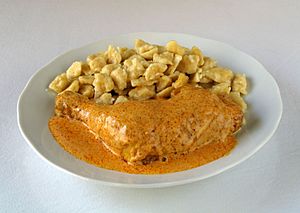
Spätzle is often served with meat dishes that have a lot of sauce or gravy. Good examples are Zwiebelrostbraten, Sauerbraten, or Rouladen. In Hungary, Spätzle is even used in soup!
Spätzle can also be the main part of a dish. Here are some popular ones:
Savory Dishes
- Linsen, Spätzle und Saitenwürstle: This dish has Spätzle with lentils and frankfurter-style sausages.
- Käsespätzle: This is a very popular dish! Spätzle is mixed with grated cheese (often Emmenthaler) and fried onions.
- Gaisburger Marsch: A traditional stew from Swabia. It's made with beef, potatoes, and carrots.
- Krautspätzle: Spätzle mixed with sauerkraut, onion, butter, and spices like marjoram or caraway.
- Spätzle mit Käse überbacken: Spätzle mixed with cheese and topped with paprika.
- Leberspätzle: Spätzle mixed with ground liver. It's often served in a clear soup broth.
- Spinatspatzeln: Spätzle that has spinach mixed into the dough. This is a special dish from Trentino-Alto Adige/Südtirol.
Sweet Dishes
- Kirschspätzle: Spätzle mixed with fresh cherries. It's served with melted, browned butter, sugar, and cinnamon or nutmeg. In the Allgäu region, people eat this as a light dinner in late summer.
- Apfelspätzle: Spätzle with grated apples in the dough. It's served with melted, browned butter, sugar, and cinnamon. In the Allgäu, this is a light dinner in autumn.
Images for kids
-
Käsespätzle (cheese Spätzle), Spätzle with cheese and onions
hu:Nokedli
See also
 In Spanish: Spätzle para niños
In Spanish: Spätzle para niños


